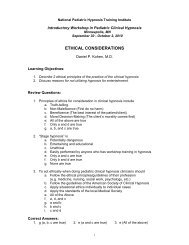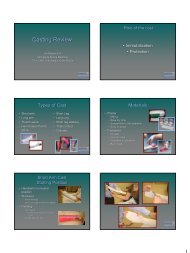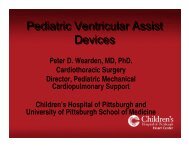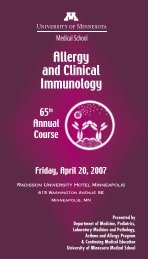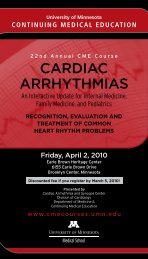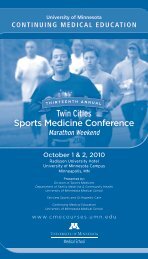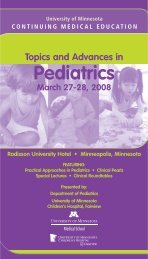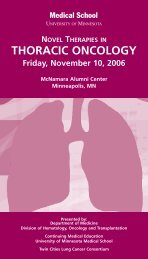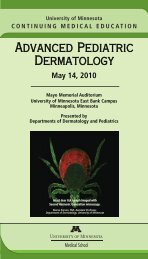34th E. T. Bell Fall Pathology Symposium - University of Minnesota ...
34th E. T. Bell Fall Pathology Symposium - University of Minnesota ...
34th E. T. Bell Fall Pathology Symposium - University of Minnesota ...
Create successful ePaper yourself
Turn your PDF publications into a flip-book with our unique Google optimized e-Paper software.
Dear Colleague:<br />
We are proud to present the <strong>34th</strong> E. T. <strong>Bell</strong> <strong>Fall</strong> <strong>Pathology</strong> <strong>Symposium</strong>. On the<br />
recommendation <strong>of</strong> previous course attendees and after careful review <strong>of</strong> potential<br />
conflicting activities and dates, we have moved the <strong>Bell</strong> <strong>Symposium</strong> one month earlier.<br />
In this fashion out-<strong>of</strong>-state visitors will be able to fully enjoy the beauty <strong>of</strong> <strong>Minnesota</strong> in<br />
the <strong>Fall</strong> and there will be no need to bring heavy coats to the meeting.<br />
This year's "<strong>Bell</strong>" will delve into recent advances in our knowledge <strong>of</strong> the pathology <strong>of</strong><br />
bone and s<strong>of</strong>t tissues. As has become evident in recent years, the pathologist who used<br />
to practice in isolation and at-a-distance is a thing <strong>of</strong> the past. Today the pathologist<br />
must be an active member <strong>of</strong> an interdisciplinary team, fully aware <strong>of</strong> his or her own<br />
role, as well as the contributions <strong>of</strong> other members <strong>of</strong> the team. Following this<br />
approach, host faculty will cover relevant aspects <strong>of</strong> the molecular biology, radiologic<br />
diagnosis <strong>of</strong> tumors, recent advances and current status <strong>of</strong> the surgical, medical and<br />
radiation therapy <strong>of</strong> sarcomas <strong>of</strong> bone and s<strong>of</strong>t tissues. Guest faculty will share their<br />
expertise on new and evolving entities in s<strong>of</strong>t tissue pathology, the skeleton in health<br />
and disease, and the differential diagnosis <strong>of</strong> epithelioid and cartilaginous tumors.<br />
We look forward to seeing you at this symposium and trust that you will find it<br />
intellectually stimulating and helpful in your daily practice. The symposium will take<br />
place at the Mayo Auditorium, in the Academic Health Center. As is customary, it will be<br />
followed the next day by the <strong>Fall</strong> Seminar <strong>of</strong> the <strong>Minnesota</strong> Society <strong>of</strong> Pathologists, this<br />
year presented by Drs. Nielsen and Folpe, who kindly agreed to participate in the E.T.<br />
<strong>Bell</strong> <strong>Symposium</strong> as well.<br />
Sincerely,<br />
J. Carlos Manivel, M.D.<br />
Department <strong>of</strong> Laboratory Medicine and <strong>Pathology</strong><br />
Course Director<br />
STATEMENT OF NEED<br />
The symposium will present recent advances in the field <strong>of</strong> bone and s<strong>of</strong>t tissue<br />
pathology. The presentations will emphasize the need for an interdisciplinary approach<br />
to diagnosis and treatment, and will focus on recently described entities, diagnostic<br />
criteria, differential diagnosis and the impact <strong>of</strong> our diagnoses on prognosis and<br />
therapeutic procedures.<br />
AUDIENCE<br />
This conference would be ideal for practicing anatomic and clinical Pathologists,<br />
Orthopaedic Surgeons, adult and pediatric Oncologists, Radiologists and Radiation<br />
Therapists.<br />
EDUCATIONAL OBJECTIVES<br />
EDUCATIONAL OBJECTIVES<br />
Following this conference, participants should be able to:<br />
• Discuss newly recognized entities in bone and s<strong>of</strong>t tissue pathology.<br />
• Describe the nosology <strong>of</strong> these entities in updated classifications.<br />
• Discuss the morphologic criteria used in recognition <strong>of</strong> these entities.<br />
• Recognize the role <strong>of</strong> the pathologist as a member <strong>of</strong> the clinical team and the<br />
importance <strong>of</strong> interactions with other members <strong>of</strong> the team.<br />
• Identify common pitfalls in the differential diagnosis <strong>of</strong> epithelioid and<br />
cartilaginous tumors.<br />
• Describe how recent advances in molecular biology can explain certain aspects <strong>of</strong><br />
the pathobiology <strong>of</strong> these tumors and how they can be used to confirm a diagnosis<br />
or to establish differential diagnoses.



